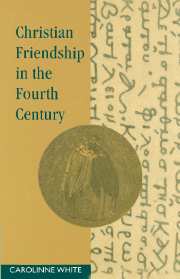Book contents
- Frontmatter
- Contents
- Preface
- Abbreviations
- 1 Introduction
- 2 Classical theories of friendship
- 3 Some problems of Christian friendship
- 4 Friendship in the lives and thought of Basil and of Gregory of Nazianzus
- 5 John Chrysostom and Olympias
- 6 Synesius of Cyrene
- 7 Ambrose of Milan – Ciceronian or Christian friendship?
- 8 St Jerome
- 9 Paulinus of Nola
- 10 Monasticism and friendship
- 11 St Augustine
- Conclusion
- Notes
- Editions and translations of primary sources
- Select bibliography
- Index
10 - Monasticism and friendship
Published online by Cambridge University Press: 06 July 2010
- Frontmatter
- Contents
- Preface
- Abbreviations
- 1 Introduction
- 2 Classical theories of friendship
- 3 Some problems of Christian friendship
- 4 Friendship in the lives and thought of Basil and of Gregory of Nazianzus
- 5 John Chrysostom and Olympias
- 6 Synesius of Cyrene
- 7 Ambrose of Milan – Ciceronian or Christian friendship?
- 8 St Jerome
- 9 Paulinus of Nola
- 10 Monasticism and friendship
- 11 St Augustine
- Conclusion
- Notes
- Editions and translations of primary sources
- Select bibliography
- Index
Summary
It was during the fourth century, as the threat of religious persecution came to an end and the supreme self-sacrifice, martyrdom, ceased to be a reality of everyday life, that Christian monasticism developed into an organised movement in both the eastern and western parts of the Roman Empire. This century, when monasticism in its various forms was spreading so rapidly, is of great importance for it was at this time that so many of the theories upon which later monasticism was to be based were first worked out. Furthermore, in these early stages of its development the monastic life was still regarded as the life of the true Christian, the Christian who was most intent on the pursuit of perfection, and was not yet seen as something very separate from the life of those Christians who did not completely renounce the things of this world: those who opted for the monastic life were merely regarded, on the whole, as preferring a more radical approach to the question of Christian perfection. As a result of this proximity between the way of the monk and the life of clergy and laity, it is possible to see how the language of the legislators and theorists of monasticism overlaps at many points with the language used by Christian writers of this period in their discussions of friendship: in several aspects the ideals of friendship in Christian terms and the ideals of monasticism appear to coincide.
- Type
- Chapter
- Information
- Christian Friendship in the Fourth Century , pp. 164 - 184Publisher: Cambridge University PressPrint publication year: 1992



